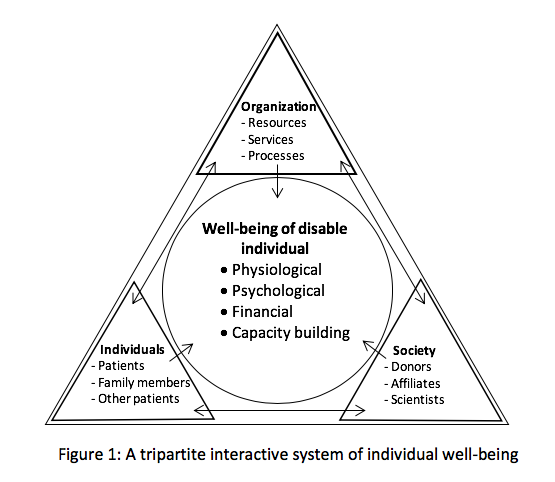I recently visited my home country, Bangladesh, for some research-related purposes. During my trip, I visited an organization that deals with treatment and wellness of disabled individuals. The organization – Centre for the Rehabilitation of the Paralysed (CRP) – is the leading organization of the country and located on the outskirt of the capital city, Dhaka. It provides healthcare and rehabilitation services to individuals who have diverse categories of movement-related disabilities or trauma.
The services are open to any individual irrespective of his or her socio-economic background and are affordable so that people with financial difficulties can get access to high-quality healthcare services. In my view, the organization has developed a wonderful system that not only works within the boundary of the organization but also extends beyond that, to develop patients’ socio-economic core in the long run. I call this system a tripartite interactive system comprising organization, individuals and society. My thoughts are depicted in Figure 1 below.

At the heart of the system is well-being of disabled individuals who visit and get services from the organization. While it is customary to think that a service provider aiming at the improvement of optimal functioning can enhance physical and psychological well-being, it is fascinating to learn that the provider can simultaneously work towards recipients’ financial well-being and capacity building.
For example, CRP provides financial support to those who are from disadvantaged or marginalized socio-economic groups. Waiving or reducing service charges and material costs is one of the mechanisms through which the organization offers financial support to needy individuals. The most remarkable aspect is enhancing well-being through capacity building of the patients: the organization offers vocational training to disabled individuals so that they can develop necessary skills for living an independent life in the future.
Examples of skill development projects include information technology (IT) training, electronic workshops, metal workshops, wood workshops, and so on. In my view, capacity building has long-lasting effects on a disable person’s financial well-being, and it is largely infuenced by the progress of his or her physiological and psychological well-being. In that sense, these well-being outcomes are connected and also impacted by organizational, individual, and societal matters.
CRP, as an organization, puts together resources for delivering services and thereby faciliating rehabilitation processes of individual patients. Like any other organization, it has human, financial and technical resources. It has a large pool of highly trained therapists and physicians who deal with different kinds of disabilities. There are also volunteers who provide therapeutic treatment and perform other ancillary tasks for the centre.
One of the unique aspects of the centre is that the organization has developed a great network of individuals, organizations and donors who contribute to its development. For example, a divisional centre of the organization was established in Rajshahi, another district, with support received from individuals and a foreign consulate. The services available and processes related to them are such that everything a patient does in a given day improves his or her mobility in one way or another.
Individuals also contribute to the well-being of patients with mobility challenges. Firstly, it is the patient himself or herself who needs to show his or her intention and willingness to follow the prescribed rehabilitation practices. It came to my understanding that many elderly patients are already so emotionally exhausted that they sometimes undermine the need to follow the treatment procedures as suggested by their therapists or physicians. But, there are patients who want to enjoy every bit of their lives and actively engage themselves in the treatment or rehabilitation procedures.
Secondly, family members play a crucial role in facilitating especially patient’s psychological well-being, when a patient is in the process of rehabilitation at the centre’s premises. Presence of important ones removes patients’ depression or fatigue caused by their poor physical condition. Thirdly, other patients help to improve a patient’s condition by developing a social network that enables them to connect with each other. For example, patients have group therapy sessions together and they interact with each other, share their stories and aspirations. The peer support helps them form teams when they engage in sporting and cultural events in the centre.
Society contributes to well-being of disabled individuals by offering donations to, forming affiliations, and conducting scientific projects with CRP. For example, CRP has individual, corporate and international donors. The donations are being invested for supporting rehabilitation of the patients and also for improving the infrastructural facilities of the centre.
The affluent individuals of the society donate funds and provide other support to the organization. CRP has both local and international affiliates who help in developing a patient-friendly organization. For example, at the international level, CRP has a supporting organization in Germany, Sweden and North America. These supporters, known as Friends of CRP, offer fund-raising support and develop awareness about the CRP and its work. Thus, the affiliates make significant contributions to well-being of the disabled individuals.
In addition, research projects are carried out by both local and international scientists. For example, CRP and Queen’s University in Canada had a joint project that developed a manual for assisting organizations and practitioners in dealing with disability when it intersects with maternal and child health issues. Thus, in my view, this tripartite interactive system connects macro, meso and micro level components at the same time to positively influence well-being outcomes for individuals with disability.
I think this system, on the one hand, allows disabled individuals to overcome fear and stigma about their lives. On the other hand, it restores their mental, physical and financial capacities so that they integrated back into their family, society and work-related spheres.
Doctoral Student
